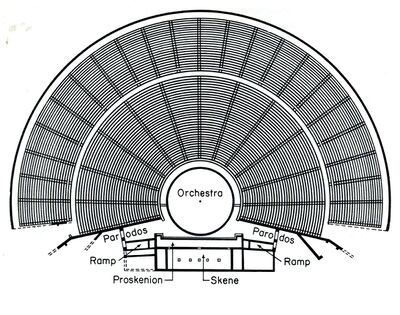The Theatre at Epidaurus[edit]
The word ‘theatre’ comes from the Greek theatron, a place for contemplating, combining the sense of seeing and thinking. In classical Greece, theatres were places to contemplate a performance during the festivals that suspended the life of the city.
In Athens, the Great Dionysiacs were the focus of the life of the polis (city) for six days. These took place three times a year: the Great Dionysiacs in spring, the Leneas in January and the Peasant Dionysiacs in December. The festivals included a procession and performances of poetry, music and song as well as on the final three days performances of three tragedies in the morning and a comedy in the afternoon. The festival was highly organised: the plays were selected at the start of the event, and judges were elected to award the prizes. The city required the wealthy citizens to act as choregos, instructing the chorus. When the polis was wealthy, everyone had free admission to the theatre; when that could not be afforded, there was a subsidy for the poorer citizens. Prizes were awarded for the choregos, for the poet (writer) and for the protagonist. The festivals were not just entertainment; they were seen as a way to think and talk about moral and political questions, and also as a means to heal patients, since there was a belief that the observation of dramatic shows had positive effects on mental and physical health.
The theatre of Epidaurus (Q7830), built around 350 B.C., has been considered since antiquity the most beautiful theatre of classical Greece. Attributed to the architect Polykleitos (Q30025), the theatre follows the characteristic tripartite structure of classical Greek theatres: theatron (auditorium), orchestra (the playing area), and skene (a structure at the rear of the stage).
Set into the side of a hill, the auditorium is arranged in an arc, curving around the circular orchestra. The lower part of the auditorium is divided into 12 wedge-shaped sections, the upper into 22 sections. A walkway separates the upper and lower parts of the auditorium. The row nearest the orchestra was reserved for the seats of honour. The layout of the auditorium and orchestra was carefully designed to achieve optimal acoustics and sightlines, ensuring the 13,000 to 14,000 spectators could see and hear.
The orchestra, the space for the chorus, is a complete circle with a diameter of 20m. At its centre is a circular stone, probably the site of a small altar or thymele. Opposite the auditorium and behind the orchestra is the stage building of the theatre, the skene. The earliest skene was a temporary structure (the word skene derives from the Greek for tent) to provide a backdrop and hide the actors changing costume. The permanent skene at Epidaurus, built of stone, was constructed in two phases: the first at the end of the 4th century BCE and the second in the middle of the 2nd century BCE. The format of the skene from the later period consisted of a two-storey building and the proscenium – a raised acting area between the orchestra and the skene. There was a colonnade at the front of the proscenium, and on both sides of the skene the building projected forward, forming wings. Two small rectangular rooms either side provided space for the performers while not on stage. Two ramps lead to the roof of the proscenium, the logeion, where the actors could also perform.
The theatre of Epidaurus was the result of a gradual evolution in the design of performance space during Greek antiquity, over a period of several hundred years. During the 5th century BC, when the tragedies of Aeschylus were performed, the theatre building was simple, without the skene. Later, perhaps motivated by a public interest in spectacle as much as drama, the skene was built and later expanded. Some commentators have observed that it is precisely when the plays are mediocre that the building is perfected!
Today, the theatre of Epidaurus attracts a large number of Greek and foreign visitors and is used once again for the performance of plays. The first modern performance to take place at the theatre was Sophocles’s tragedy Electra in 1938, and from 1955 there were annual performances of ancient drama. The Epidaurus Festival now continues each year during the summer months.
2,300 years ago, the people of the cities of ancient Greece invested substantial resources to build theatres and make performances, for all the citizens to attend. The format was developed and refined over several centuries, resulting in a space where thousands of people could hear, watch and think about the performance. The Greeks created the template for every Western theatre: a place for seeing and contemplation, where a society can see itself performed.

